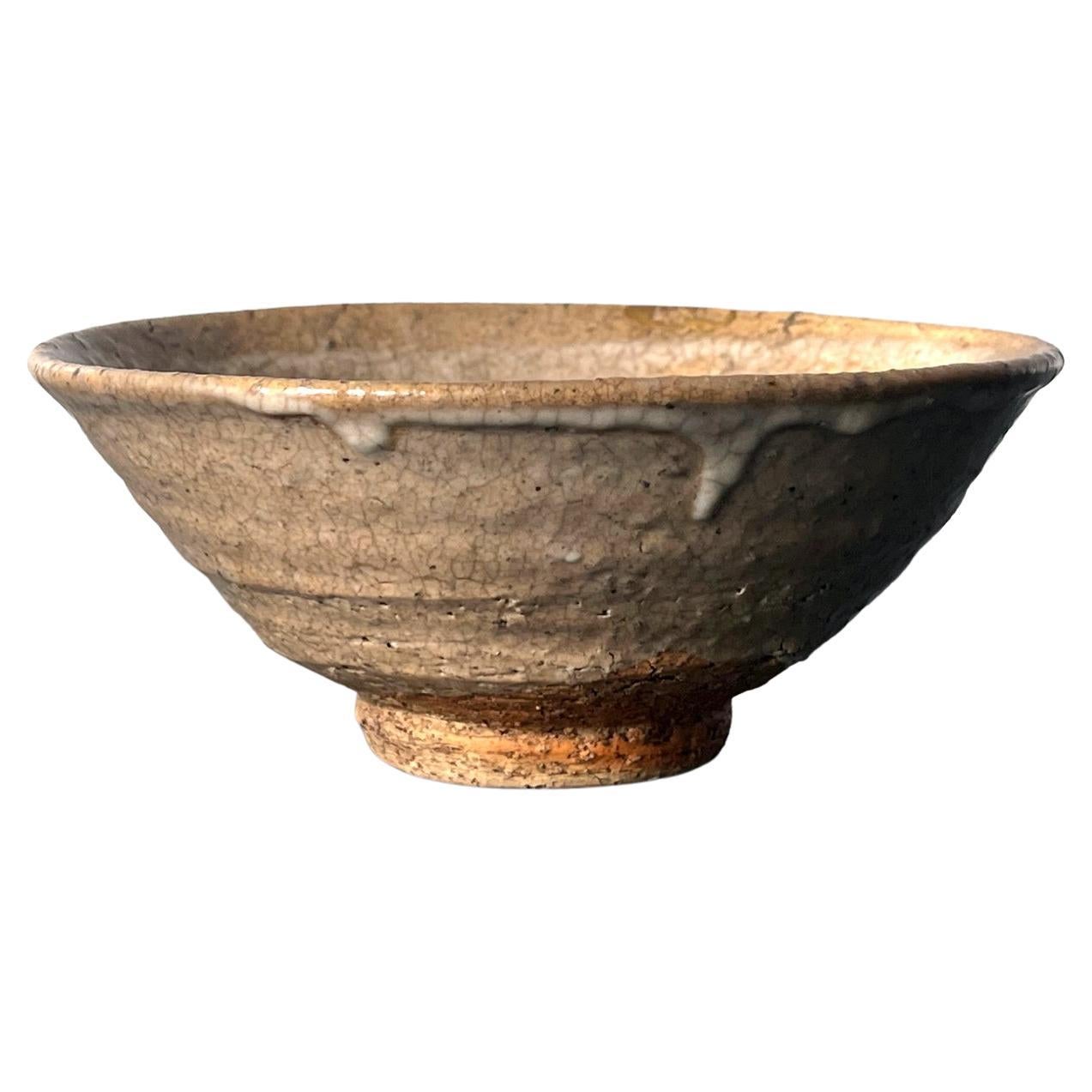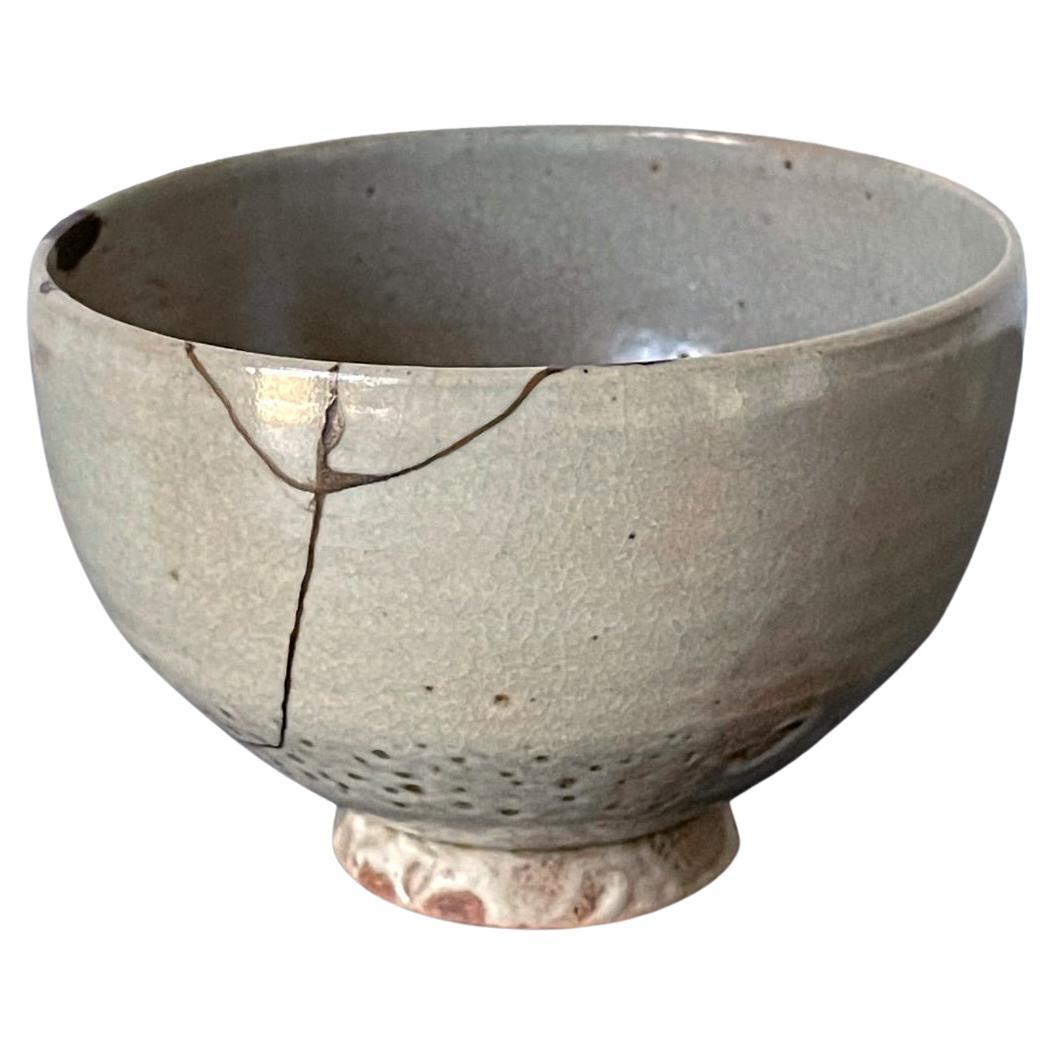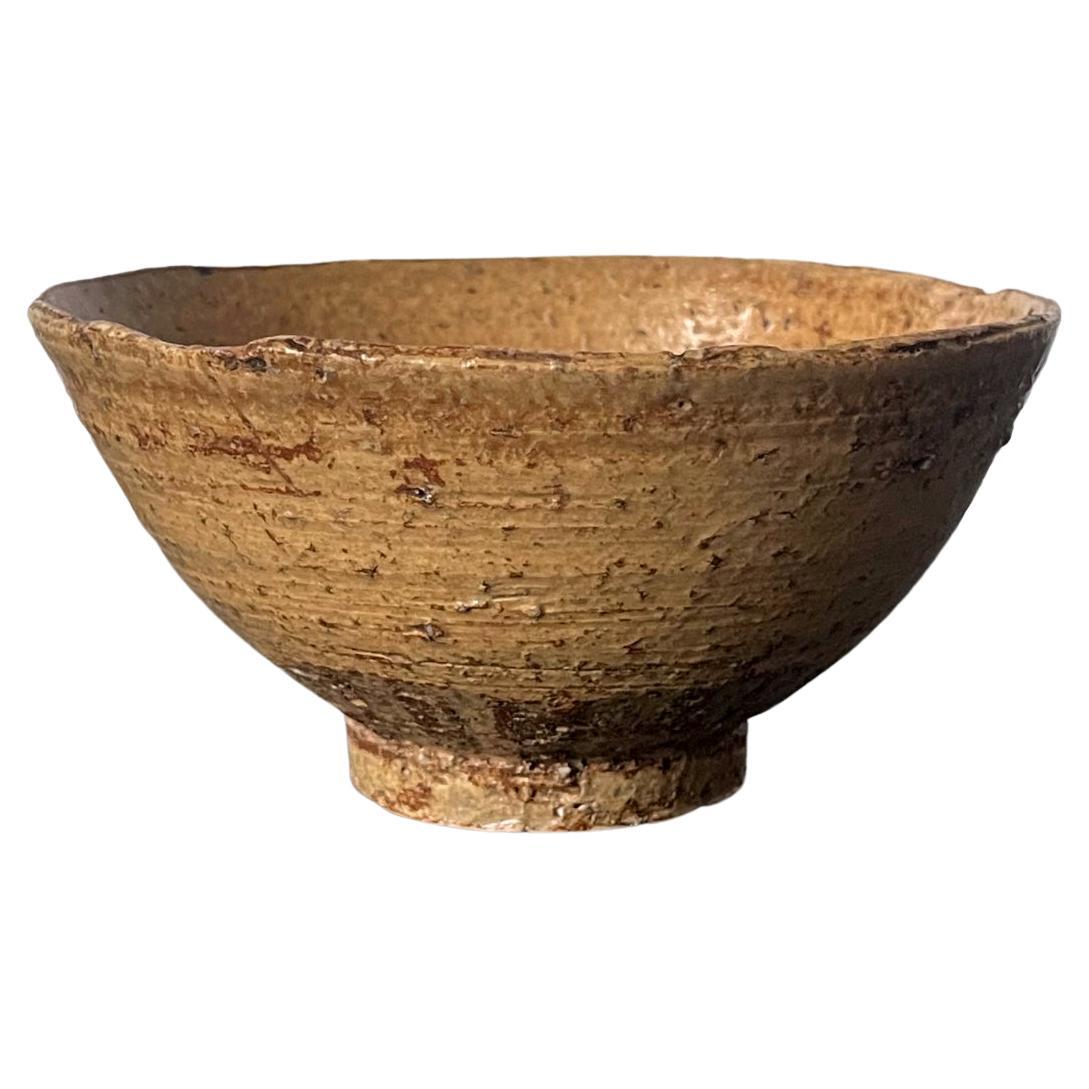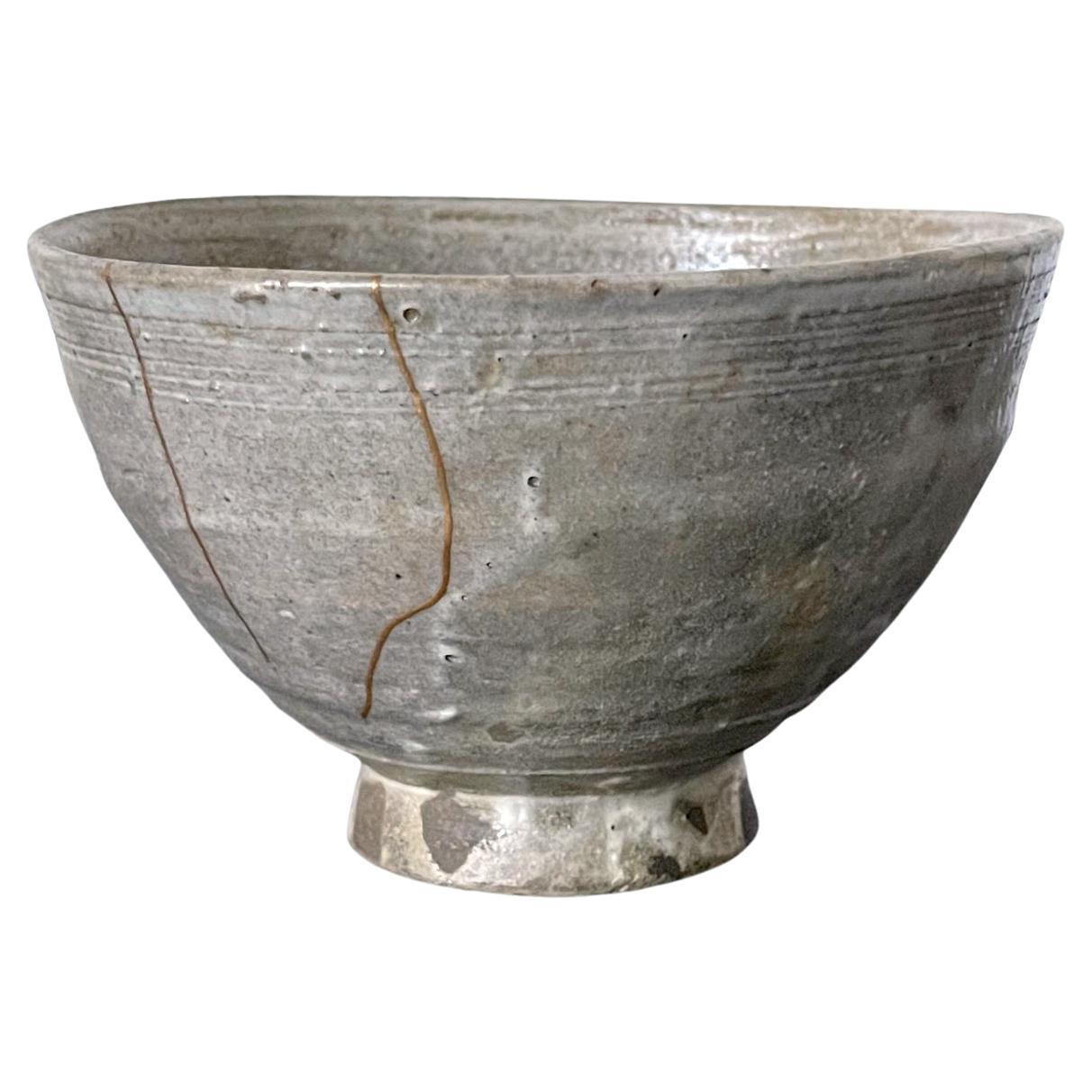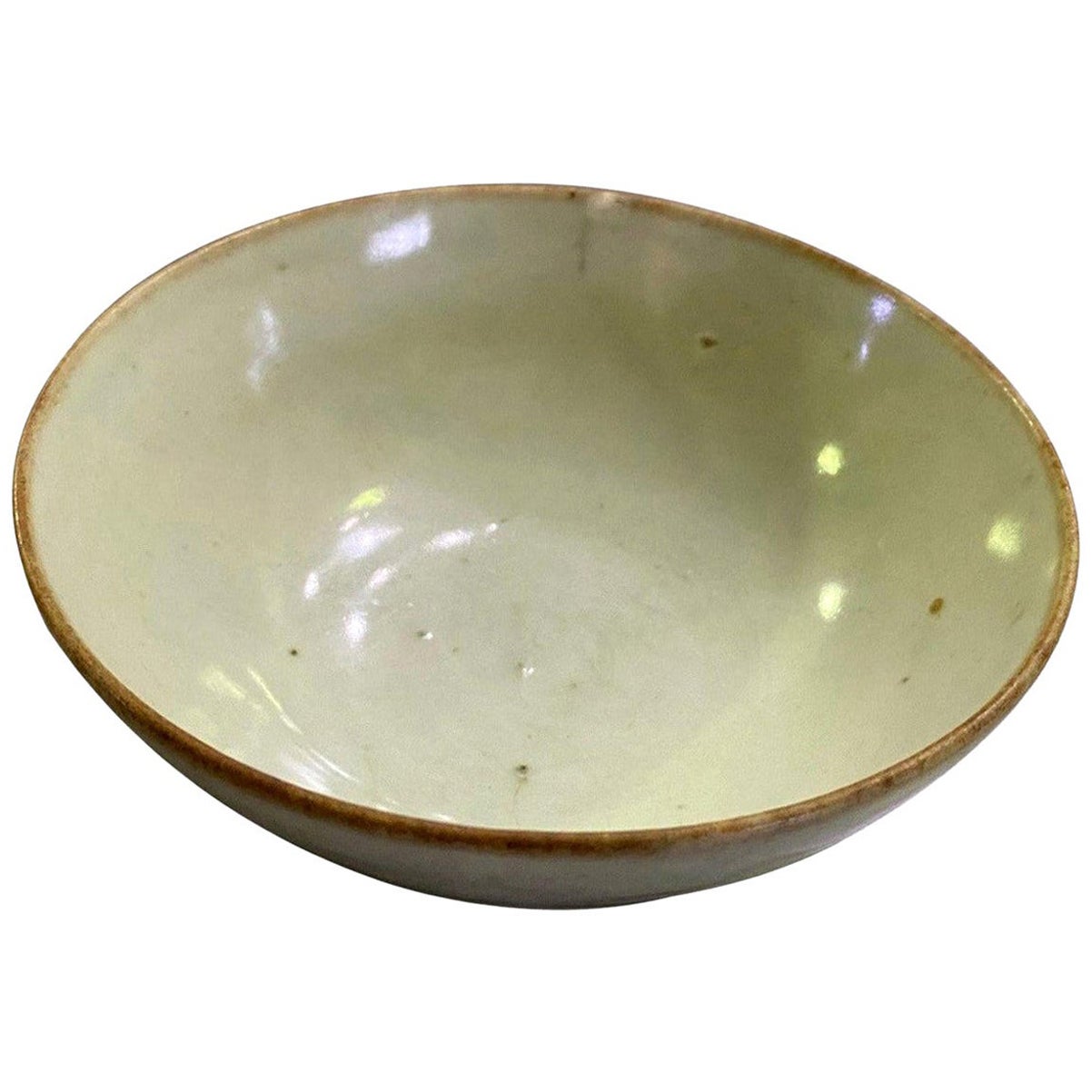Items Similar to Antique Korean Mishma Tea Bowl Chawan Joseon Dynasty
Want more images or videos?
Request additional images or videos from the seller
1 of 14
Antique Korean Mishma Tea Bowl Chawan Joseon Dynasty
About the Item
A Korean Hori-Mishima Chawan (tea bowl) circa 16th-17th century (Joseon Dynasty). The tea bowl is of an upright conical form supported by a high foot ring. It was decorated with incised brushwood fence patterns filled with white slip on both the interior and exterior surface. These dominant motifs were spaced by three encircling double lines. Seven chrysanthemum flowers (inka) were stamped on the lower interior surrounding a swirling tea well on the bottom. There are six spur marks known as Meato in Japanese on the interior bottom and a pointy spot in the center of the foot ring known as Tokin. Two crack lines were historically repaired by superb Kintsugi, adding a mysterious wabi-sabi appeal to the piece.
The Hori-Mishima bowl was also known as Gohon Mishima. It was made in Bushan Kilns of the Southern Gyeongsang Province specifically for the Japanese market in the 16th-17th century, when the tea ceremonies in Japan demanded such ware. The bowl comes with a purple fabric pouch and a later wood storage tomobako box.
Historically the decorative techniques used on this bowl as well as many other contemporary Buncheong ware evolved from Celadon inlays from Goryeo period. Designs were carved, etched, incised or stamped into the clay before the entire piece was coated in white slip, and after the excess was scraped off, only the designs filled with white slip were left. Finally, the piece is coated with a transparent glaze.
- Dimensions:Height: 3 in (7.62 cm)Diameter: 5.3 in (13.47 cm)
- Style:Other (Of the Period)
- Materials and Techniques:Ceramic,Glazed
- Place of Origin:
- Period:
- Date of Manufacture:16th-17th Century
- Condition:Repaired: Historical kintsugi repairs as shown. Wear consistent with age and use. Fine condition with surface patina.
- Seller Location:Atlanta, GA
- Reference Number:1stDibs: LU945031512072
About the Seller
5.0
Platinum Seller
These expertly vetted sellers are 1stDibs' most experienced sellers and are rated highest by our customers.
Established in 2006
1stDibs seller since 2010
480 sales on 1stDibs
Typical response time: <1 hour
- ShippingRetrieving quote...Ships From: Atlanta, GA
- Return PolicyA return for this item may be initiated within 2 days of delivery.
More From This SellerView All
- Korean Ceramic Irabo Tea Bowl Chawan Joseon DynastyLocated in Atlanta, GAA ceramic chawan tea bowl made in Korea for Japanese market circa 17th century. The chawan is identified as Irabo type. Irabo bowls were essentially con...Category
Antique 17th Century Korean Other Ceramics
MaterialsCeramic
- Korean Ceramic Ido Tea Bowl Chawan Joseon DynastyLocated in Atlanta, GAA ceramic stoneware chawan tea bowl made in Korea circa 16-17th century. The chawan is identified as Ko-ido (small ido) due to its size and form. Ido bowls were made since 15th centu...Category
Antique 17th Century Korean Other Ceramics
MaterialsCeramic
- Antique Korean Ceramic Gohon Chawan Tea Bowl Joseon DynastyLocated in Atlanta, GAA ceramic chawan (tea bowl) circa 17-18th century fired in the Busan kiln in Southern Korean specifically for the Japanese market. The kilns were contro...Category
Antique 17th Century Japanese Edo Ceramics
MaterialsCeramic
- Korean Ceramic Ki-Irabo Tea Bowl Chawan Joseon DynastyLocated in Atlanta, GAA ceramic chawan tea bowl made in Korea for Japanese market circa 17th century. The chawan is identified as Ki- Irabo type (Yellow Irabo). Irabo bowls w...Category
Antique 17th Century Korean Other Ceramics
MaterialsCeramic
- Korean Gohon Chawan Tea Bowl for Japanese Market Joseon DynastyLocated in Atlanta, GAA ceramic chawan (tea bowl) circa 17-18th century fired in the Busan kiln in Korean specifically for the Japanese market. The kilns were run by the So c...Category
Antique 17th Century Japanese Edo Ceramics
MaterialsCeramic
- Antique Korean Ceramic White Bowl Joseon DynastyLocated in Atlanta, GAA Korean ceramic rice bowl covered in a white glaze with a hint of bluish green color circa 19th century toward the end of Joseon Dynasty. The deep bowl...Category
Antique 19th Century Korean Other Ceramics
MaterialsCeramic
You May Also Like
- Korean Joseon Dynasty Glazed Pottery Ceramic Hakame Chawan Tea BowlLocated in Studio City, CAA wonderful Joseon Dynasty (1392-1897) Korean pottery bowl with a beautiful muted glaze, color, and nicely aged patina. As this is not our area of expertise, we are listing it si...Category
Antique 19th Century Korean Ceramics
MaterialsPottery
- Korean Joseon Dynasty White Glazed Pottery Ceramic Chawan Tea BowlLocated in Studio City, CAA wonderful Joseon Dynasty (1392-1897) Korean pottery bowl - perhaps a monk's Chawan tea bowl. The work features a beautiful white glaze, wonderful organic shape, engaging design and...Category
Antique 19th Century Korean Ceramics
MaterialsCeramic, Earthenware, Pottery
- Korean Joseon Dynasty Glazed Pottery Ceramic Hakame Chawan Tea Bowl DishLocated in Studio City, CAA wonderful Joseon Dynasty (1392-1897) Korean pottery bowl/ dish with a beautiful muted glaze, color, and nicely aged patina. As this is not our area of expertise, we are listing...Category
Antique 19th Century Korean Ceramics
MaterialsPottery
- Kichizaemon Raku Seinyu XIII "13th" Signed Antique Japanese Raku Chawan Tea BowlLocated in Studio City, CAA wonderfully glazed, impeccably made Chawan tea bowl by famed Japanese master potter the 13th Kichizaemon Raku, Seinyu (1887-1944) who was the eldest son of Konyu - the 12th Kichizaemon of the Raku family line of potters - known as the most noted and celebrated tradition of pottery within the world of Japanese tea. Kichizaemon Raku was the 13th master to carry on the family's esteemed name and tradition. The bowl features shifting textures and deep, rich colours which radiate in the light. The term "Raku" was derived from the site where clay was dug in Kyoto in the late 16th century. The Kanji character for Raku translates to "enjoyment" or "fun/delightful" For 15 generations it has been the title and seal used by a lineage of potters whose work formed the central tradition in Japan. This lineage believes that 'Raku' refers to the potters who use the technique, not the technique itself. In the 16th century, the first of these potters, Chojiro is said to have come under the patronage of the Japanese tea master, Sen-No-Rikyu. According to legend, in 1598 a few years after Chojiro's death, ruler, Hideyoshi Toyotomi bestowed upon his adopted son, Jokei, a golden seal with the written symbol "Raku." Both the name and the ceramic style have been passed down through the family to the present ever since. The name and the style of ware have become influential in both Japanese culture and literature. Raku ware marked an important point in the historical development of Japanese ceramics, as it was the first ware to use a seal mark and the first to focus on close collaboration between potter and patron. Other famous Japanese clay artists...Category
Early 20th Century Japanese Meiji Ceramics
MaterialsCeramic
- Vintage Japanese Oribe Ware Tea Bowl, Chawan, by Matsumoto TetsuzanLocated in Austin, TXA charming vintage Japanese oribe glazed chawan by Matsumoto Tetsuzan (b. 1955), Seto, Japan. The tea bowl, called a chawan, wonderfully potted with...Category
Early 2000s Japanese Edo Ceramics
MaterialsStoneware
- Kaneshige Toyo National Treasure Signed Japanese Bizen Pottery Chawan Tea BowlLocated in Studio City, CAA beautiful, perfectly shaped antique Bizen ware Chawan tea bowl by renowned Japanese master potter/artist Kaneshige Toyo (1896-1967) featuring a unique natural, organic forming ash glaze. Kaneshige is universally considered to be the founder of modern Bizen pottery. In 1956, Kaneshige was certified as a Living National Treasure (Important Intangible Cultural Heritage) for his work in Bizen Ware pottery/ceramics. Bizen Ware is a type of Japanese pottery traditionally from the Bizen province, presently a part of the Okayama prefecture. It is considered one of the Six Ancient Japanese Kilns (along with Echizen ware, Seto ware, Shigaraki ware, Tamba ware, and Tokoname ware). The piece is signed/ sealed on the base with one of Kaneshige's traditional incised marks. A rather engaging and scarce work. Would be a fantastic addition to any Japanese/Asian pottery or Bizen Ware collection or eye-catching stand-alone work in about any setting. Kaneshige's work can be found in numerous prominent collections and museums including: Aichi Prefectural Ceramic Museum, Seto, Japan Brooklyn Museum, NY Hagi Uragami Museum, Yamaguchi, Japan Honolulu Art Museum, HI Ibaraki Ceramic Art Museum, Kasama, Japan Indiana Art...Category
Mid-20th Century Japanese Showa Ceramics
MaterialsStoneware

